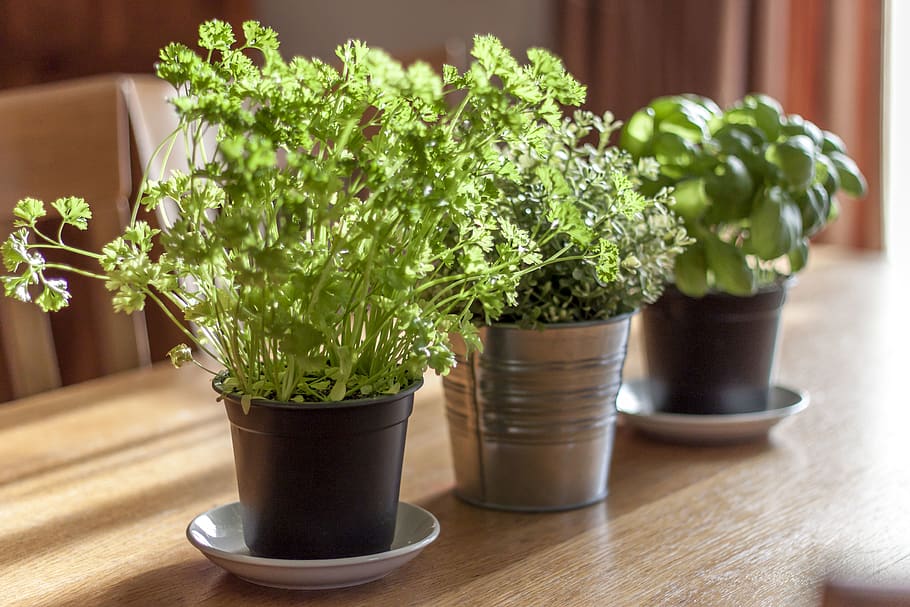
Growing an indoor or outdoor herb garden can be just as useful as it is fun! My boys and I have been working on a few projects since the beginning of 2020 and growing a successful little herb garden has been one of them. Of course it always helps if you have or know of someone with a green thumb. For me, that’s my sister! She taught me a lot of valuable insights when it came to taming chives, splitting parsley pods, and fluffing up basil bushes. If it wasn’t for her, my indoor creations would have been a flop. So now that I’ve mastered a few of these tricks, I’m going to share them with my KARA family! But first, let’s check out the benefits!
Herbaceous Benefits
Herbs have a wide variety of health benefits, including fighting infections (basil), reducing nasal congestion from allergies (rosemary), and relieving nausea and IBS symptoms (peppermint). They are also known to keep teeth healthy and freshen breath! Check out more benefits here.
Michigan State University also advocates that gardening has plenty of developmental benefits for children! Zipping around the lawn with tools and bags of seeds provides practice for gross motor skills. Pinching little seeds and grasping hand tools help develop fine motor skills. Playing with water and soil helps provide children with sensory play. Children are also able to develop reading skills when looking at garden tags, math skills when counting seeds, and a love of nature through nutritional education. And let’s not forget all the fresh air and exercise that are good for every family member! Check it out here.
Green Goodness
So now that we are familiar with the goodness of these greens, let’s start making our own from scratch!
What we need is:
- A medium to large pot with holes in the base
- Gardening soil (or a glass jar for sprouts)
- Seeds of desired herbs
Seeds that we planted included basil, garlic greens, sunflower greens, alfalfa sprouts, and a very cool little plant called burgundy oxalis. We also inherited a pot of chives that we have been mothering diligently.
I chose these plants because they are very easy to grow and work for a variety of dishes. I did try my hand at favourites like cilantro and parsley but found these extraordinarily temperamental. The cilantro came up all spindly and the parsley didn’t even germinate. Oh well – I’ll just have to keep practicing!
So let’s get down to the whys and hows of the plants that were successful! Oxalis burgundy shamrock grows wild in Alberta. Purple basil – nutmeg and basil. Lemon basil. Garlic greens! Alfalfa sprouts 5 days. Sunflower greens. Pea sprout 3 inches
Chives
Chives are the only plant I haven’t kept in my kitchen herbarium. That’s because they do so well outdoors! Chives are a perennial plant (they come back year after year) and can easily be grown indoors and out. Be careful with them though because their beautiful flowers spread seeds like crazy as they try to invade and take over your entire garden. Very edible and delicious, they are an onion that can be used in any pasta dish and can even be enjoyed raw from the garden.
I was lucky to inherit my already well established chives from a friend who planted them in their own large pot. This prevents them from getting out hand. However, as I understand it, chives are best planted and grown in cooler seasons like spring. In early May, my outdoor chives are already starting to bloom! They also prefer sunny spots and to be planted in well-draining, well-composted soil. Ensure that they are planted in the ground or a pot with holes in the base to prevent drowning. Sow seeds 2 inches apart and no more than ¼ inch deep (quite shallow with a sprinkling of soil on top). Harvesting them actually produces more chives if done properly as you can take one third of them by thinning them every couple of weeks. Just pick one stock for every three and you will always have happy chives!
Basil
Basil thrives in a sunny window in well-drained soil. It is super sensitive to cool weather so it sits in my south facing window right next to my kitchen sink. I find some herbs smell even when not cooking and basil is certainly one of them! Its powerful aroma is very pleasant though and really makes doing dishes more delightful.
Sowing seeds is very easy but must be done 10 to 12 inches apart. I only planted one as space was a commodity in my little herbarium, but that didn’t stop the basil from becoming one of the main attractions! It grew into a little tufty plant and if I kept taking leaves from the top, the basil got bushier and bushier on the bottom! Another super cool thing about basil is that you can take a cutting and germinate a new plant! Select a 4 inch section of basil that has not yet flowered and place it in water. Roots should form within a week and you can gift it to a close friend or make a second thriving plant. Totally awesome!
Another note – if you decide to plant purple basil instead of the regular kind, it tastes like nutmeg!
Garlic and Sunflower Greens
This was one plant that resulted from trial and error. My husband decided to grow his own garlic from a clove bought from the store. He brought home some garlic, ate almost all of it, but saved the last clove and buried it in a corner of the herbarium. Within a couple of days it had sprouted into what looked like a green onion stalk, and it didn’t stop there… My husband and I even started measuring its growth day by day, it was growing that fast! We placed a few bets too to see when it would outshine my other plants. I called my sister to see what her thoughts were. She said that although it would never produce new cloves, the garlic green that was growing, at a surprisingly fast rate, was deliciously edible and very much worth the short amount of time it took to grow. We would chop off the green top little by little to munch on as a snack – absolutely scrumptious!
We later found out we can also do this with sunflower seeds (not roasted ones) harvested from our sunflowers. They make nice little greens that taste great in a salad!
Alphalpha Sprouts
These quick to germinate little sprouts are very easy to grow – and you don’t even need dirt! Just a glass jar and paper towel will work! Place about 2 tablespoons of alfalfa seeds in a glass jar and let them soak in 1½ cups of water overnight (6+ hours). Drain them through the paper towel (or cheese cloth or dish cloth). Put them back in the jar and add ½ cup of fresh water. Swill them around to wash them and drain again. Then leave the jar on its side with paper towel over the opening to allow them to spread out and the moisture to be partially trapped. Repeat the rinsing and draining process every morning and evening for 4 days, always leaving the jar on its side. The sprouts will be roughly 3 to 4 cm in length with green tips when ready to eat. You can then put them in a sealed container in the fried until needed. I also noticed that they lasted longer when wrapped in paper towel then in a baggie. Add to sandwiches and salads for a delectable treat!
Burgundy Oxalis
By far the coolest thing I’ve ever grown, this bushy plant grows easily and tastes exactly like a crisp green apple! For someone who is allergic to apples, this was a very welcome treat. Also known as purple shamrock, this plant is a type of clover. And with that said, it does contain a small amount of acid which can be toxic in high doses. Used in many foods found in the supermarket, the US National Institute of Health notes that it is safe for people who eat a variety of foods.
This plant tends to prefer shade but I’ve left two in my indoor herbarium facing a south facing window and they seem to love it! Both plants have grown into bushy clusters that overtake a few others. If planted in the garden, beware as it likes to get out of control.
Plant burgundy oxalis in well-drained soils and keep it well watered. Plant it in a shadier spot. If you want to keep it growing big but control it from spreading, pluck the little yellow flowers before they bloom. All the leaves, stems and flowers are edible on this plant – but refrain from eating too much!
Our Blossoming Best
So, there you have it. With minimal supplies, you can easily start your own growing adventure. While we’ve discussed several plants, there really are endless possibilities. I recommend that you plant what you most often use in your own cooking. This can be heavily influenced by your favourite cuisines, so if you love Italian food, perhaps basil and thyme might be good choices. If you enjoy Mexican, perhaps cilantro and oregano. Just remember that it’s always nice to try new things! I hope this has been helpful and has inspired you to start down the incredibly rewarding path of beginning your own small garden!
